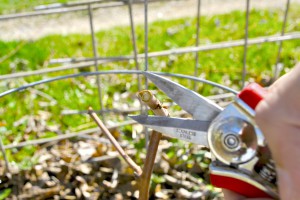by Stark Bro's
Here is a great article from Stark Brothers Nursery on testing your fruit trees or vines to see if they made it through the winter.

When spring finally arrives, plants and trees start to wake up, and the gardening world gets exciting! It is also the time of year to evaluate what survived the winter. One common misconception this time of year is that all trees and plants wake at the same time. When we compare dormant plants and trees to things that are already waking in our gardens, it’s like comparing apples and oranges.
Today, we’re going to equip you with one of the most handy tools that you can use to determine what’s still living: The Scratch Test.
1. Scratch Test: Fruit Trees

The most telltale way to determine if your young dormant trees are still alive is by checking the cambium layer under the bark. The task is simple!
What you need:
- Your thumbnail or a smooth knife
How to do a scratch test:
- With your thumbnail or knife, lightly scratch a small spot into the bark of the tree’s trunk (in a location about halfway up the tree).
- Look for wet tissue beneath the bark layer that is scratched back. It should have a greenish hue — this is living tissue.
If you find that the cambium layer beneath the bark has become dry, brittle, and brown, then it indicates that the tree has failed to live.
Top: living tree; Bottom: dead tree [click images to view larger]:


Sometimes, after performing a scratch test, you may discover the tree’s trunk shows no signs of life even though new growth still sprouts from the roots. This happens in grafted trees if the top-portion (the grafted variety) dies while the rootstock goes on living. If this happens, then it is best to replace the tree. Letting just the rootstock grow will result in a tree that lacks the qualities of the grafted variety you originally chose to plant. Rootstocks are used for characteristics like dwarfing and hardiness, and are often not ideal candidates for fruit-bearing trees.
Things to avoid when performing a scratch test:
- Do not cut a large wound into the tree to determine whether or not it is living. A small spot will suffice.
- Large wounds cut into your tree will require more effort to heal over.
- Do not perform a scratch test on a branch/limb of the tree.
- Testing the trunk is necessary. Limbs can break/die without determining the status of the rest of the tree.
2. Scratch Test: Berry Plants & Vines
For berry plants and vines, you can still attempt a scratch test to identify the living tissue. Simply follow the steps above for a scratch test on trees, and adjust to accommodate the size of the berry plants’ canes or vines. Pick a spot on the young cane/vine that is a few inches above the soil level to scratch.


Many berry plants send new growth up from their roots, so a dead cane may not determine a dead plant; however, a living cane will determine a living plant. With that in mind and, since some plants may feature thorns, you may prefer pruning in order to look for living tissue in your berry plants and fruiting vines.
3. Prune Back: Berry Plants & Vines
What you need:
- A pair of sharp and clean pruning shears
How to prune to check for living tissue:
- With your pruners, cut from the tips of the canes, working your way back toward the ground.
- Cut the canes back little by little and check for signs of life after each cut.
- Stop cutting back once you reach green, living tissue.

You are still looking for greenish, wet, living wood, but it may be necessary to cut dry dead tips back to find it. Cutting this dead wood away also helps the plants to sustain healthy growth during the growing season.
If your berry plant exhibits no living tissue in the canes above the ground, and you are also not seeing any new growth sprout from the root system well into the growing season, then your berry plant is likely no longer living. Replacing the berry plant is recommended in this case. It would also be a good time to assess water drainage, soil nutrients, and soil pH in that location if the cause of death is unknown.
Now that you know how to check to see if your plants and trees are living, it’s also important to know that, if they are still dormant, they simply need more time to break dormancy — especially if this is their first growing season in your yard! Each year, the seasons and the weather are slightly different, but living plants and trees will always wake up when they’re ready.
Blogger Labels:
Scratch,
Test,
Trees,
Plants,
tools











